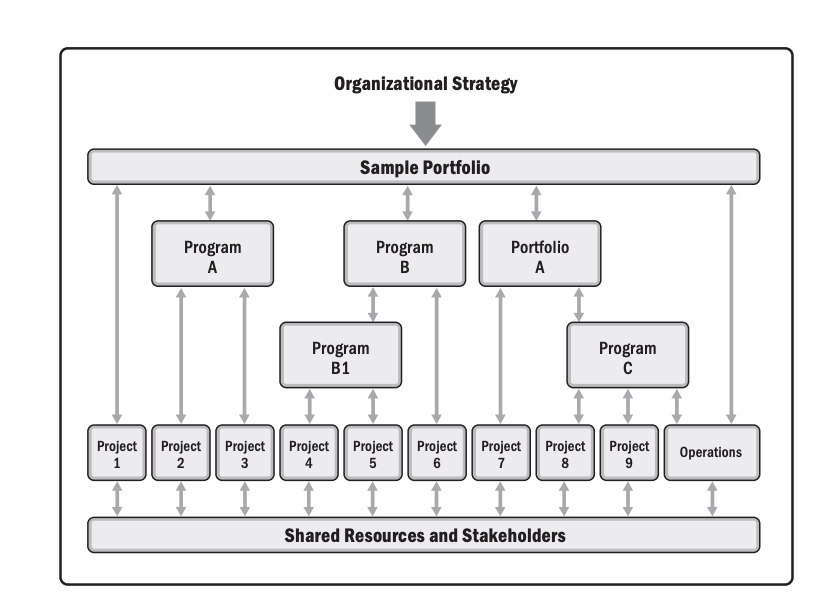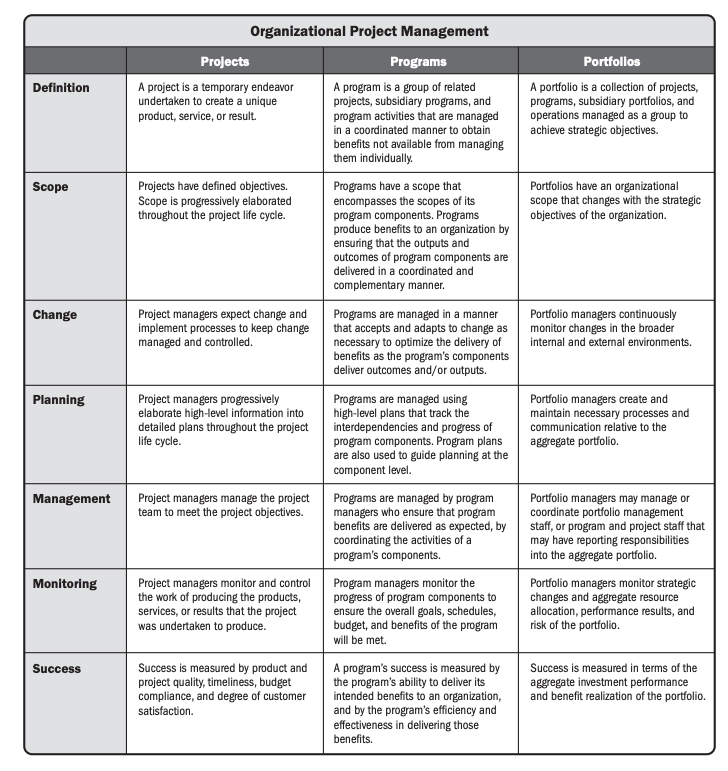To understand the fundamental difference between Project, Program and Portfolio Management, lets dive into what the words ‘Project’, ‘Program’ and ‘Portfolio’ actually stands for. These are very similar sounding functions but very different in nature.
‘Projects’ according to the Project Management Institute (PMI) are the temporary endeavors undertaken to create a unique product, service or outcome. Projects are generally bound by cost, resources, scope and time constraints with clear defined end-date.
‘Program’ on the other hand is the collection of interconnected/related projects, or subsidiary programs working towards a bigger long-term business objective focusing on achieving strategic benefits and organizational growth, which would not have been possible if managed separately.
While ‘Portfolio’ refers to the group of related or unrelated project, programs, subsidiary portfolio and operational work managed as a group to achieve strategic objectives.
Figure 1 below from the 4th edition of the Standards of Program Management provides an example of how a portfolio of programs can be organized to achieve overall organizational strategy.

Now that we have a clear understanding of the three terms – Project, Program and Portfolio, lets look at it how the differences in its management and the application;
‘Project Management’ according to PMI is the application of knowledge, skills, tools and techniques to meet the project requirements within defined constraints of time, cost and scope. The overall project management falls into these five categories;
- Project Initiation
- Project Planning
- Project Execution
- Project Monitoring and Controlling
- Closing
‘Program Management’ according to PMI is the application of knowledge, skills, and principles to obtain benefits and control not available by managing the projects or subsidiary program individually. It focuses on the coordinated and effective delivery of benefits derived from the pursuit of a group of projects and other programs whose outcomes are related.
Lastly, ‘Portfolio Management’ according to PMI is the centralized management of one or more related or unrelated portfolios, programs and projects. Portfolio Management focuses on the establishment and use of good practices when choosing programs or projects to sponsor, prioritizing their goals and work associated, and ensuring that they are sufficiently resources.
Figure 2 below from the 4th edition of the Standards of Program Management provides a comparison of project, program and portfolio management.

The difference among the project, program and portfolio management can be understood better with the type of interactions among the managers to achieve organizational objective.
Portfolio Managers ensure that programs and projects are selected, prioritized, and staffed according to the organization’s strategic plan for realizing desired organization vision and value.
While, Program Managers focuses on delivering organizational benefits through coordinated management of projects, and subsidiary programs.
And Project Managers focuses on delivering specific outcomes from their individual projects required by an organization.
Benefits of Program Management
- Better management and coordination of the interconnected projects and tasks.
- Proper resource utilization
- Resolve interdependent resource constraint
- Improved overall organization performance and benefits realization
Benefits of Portfolio Management
- Best utilization and allocation of resources among the projects or programs
- Continuous support to programs and projects
- Less conflicts and improved communication and coordination among programs and projects.
Source: Project Management Institute (PMI)
